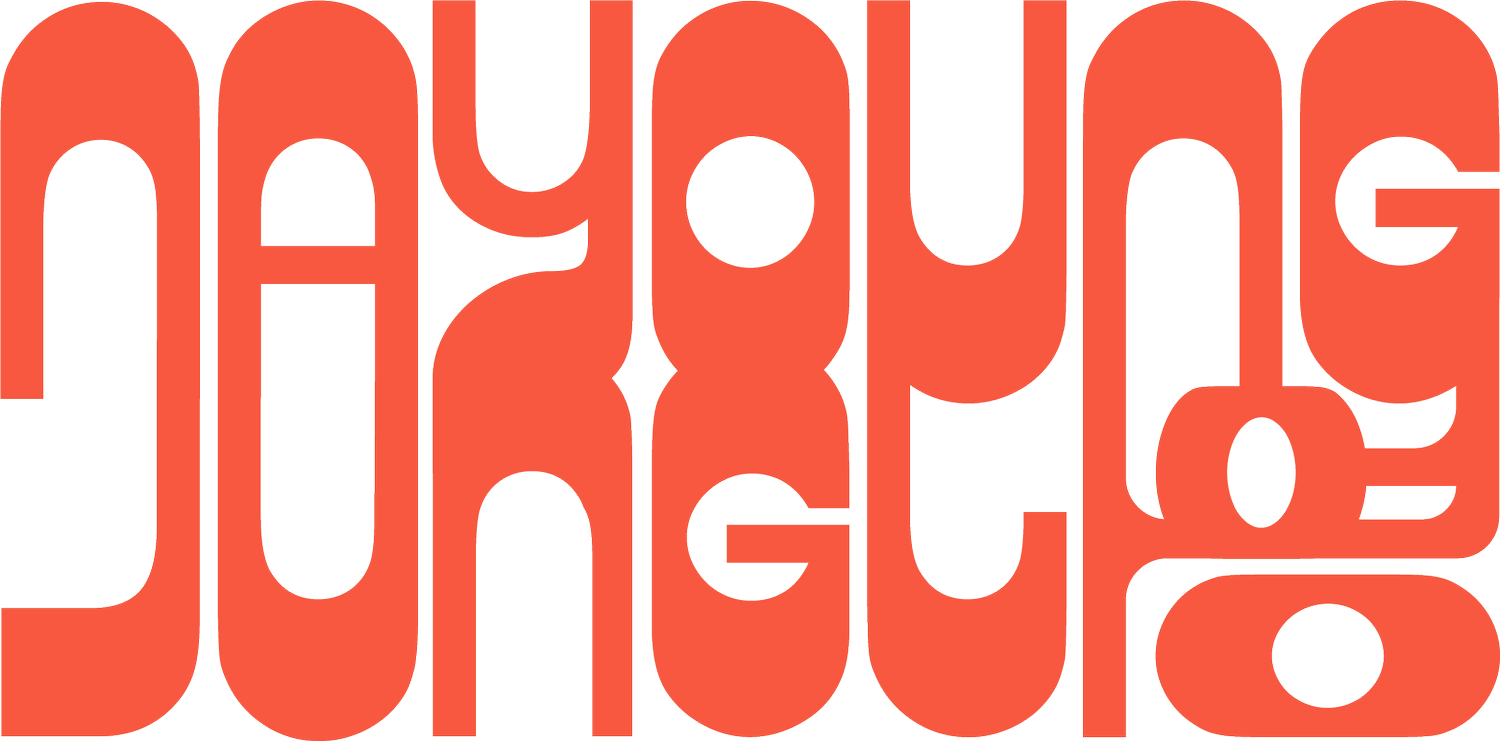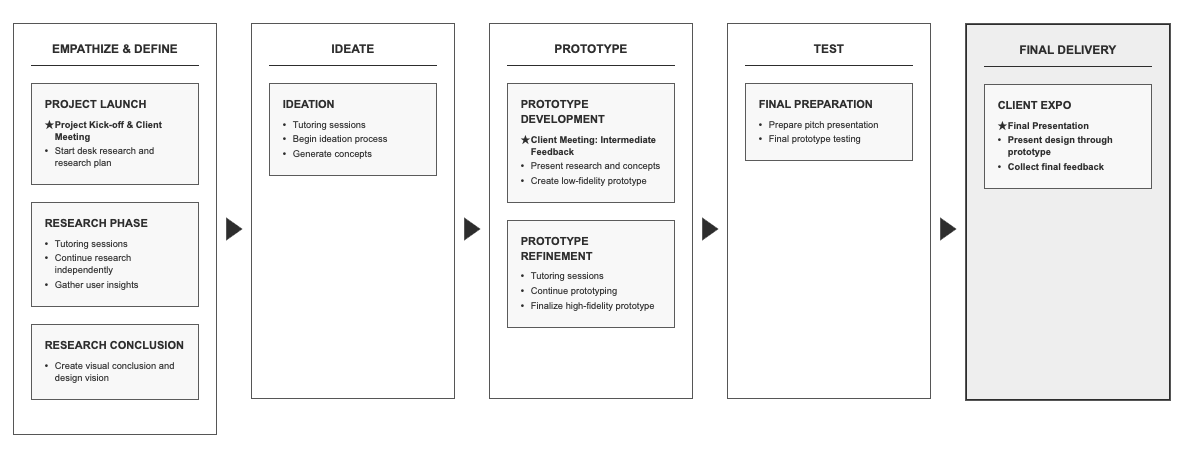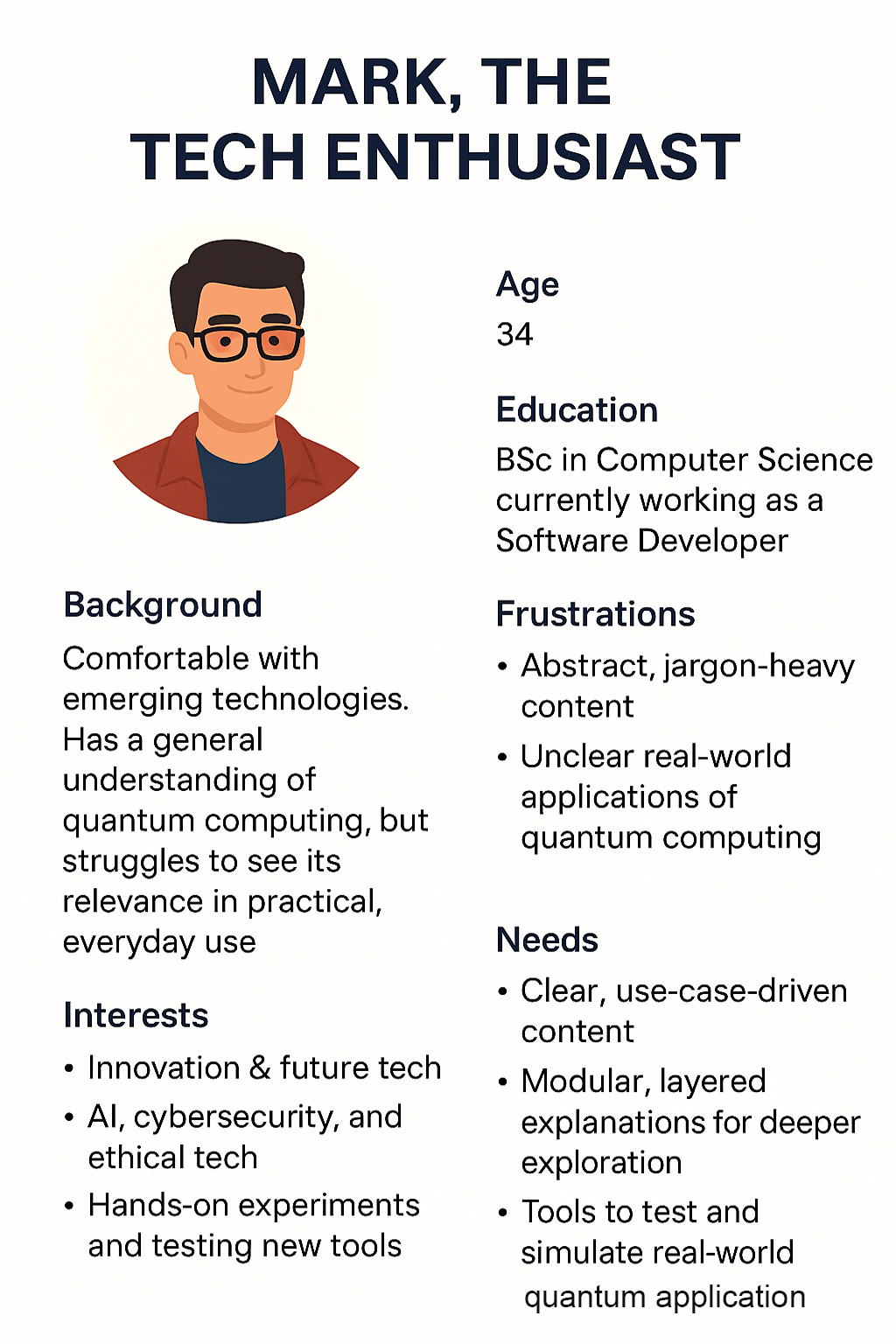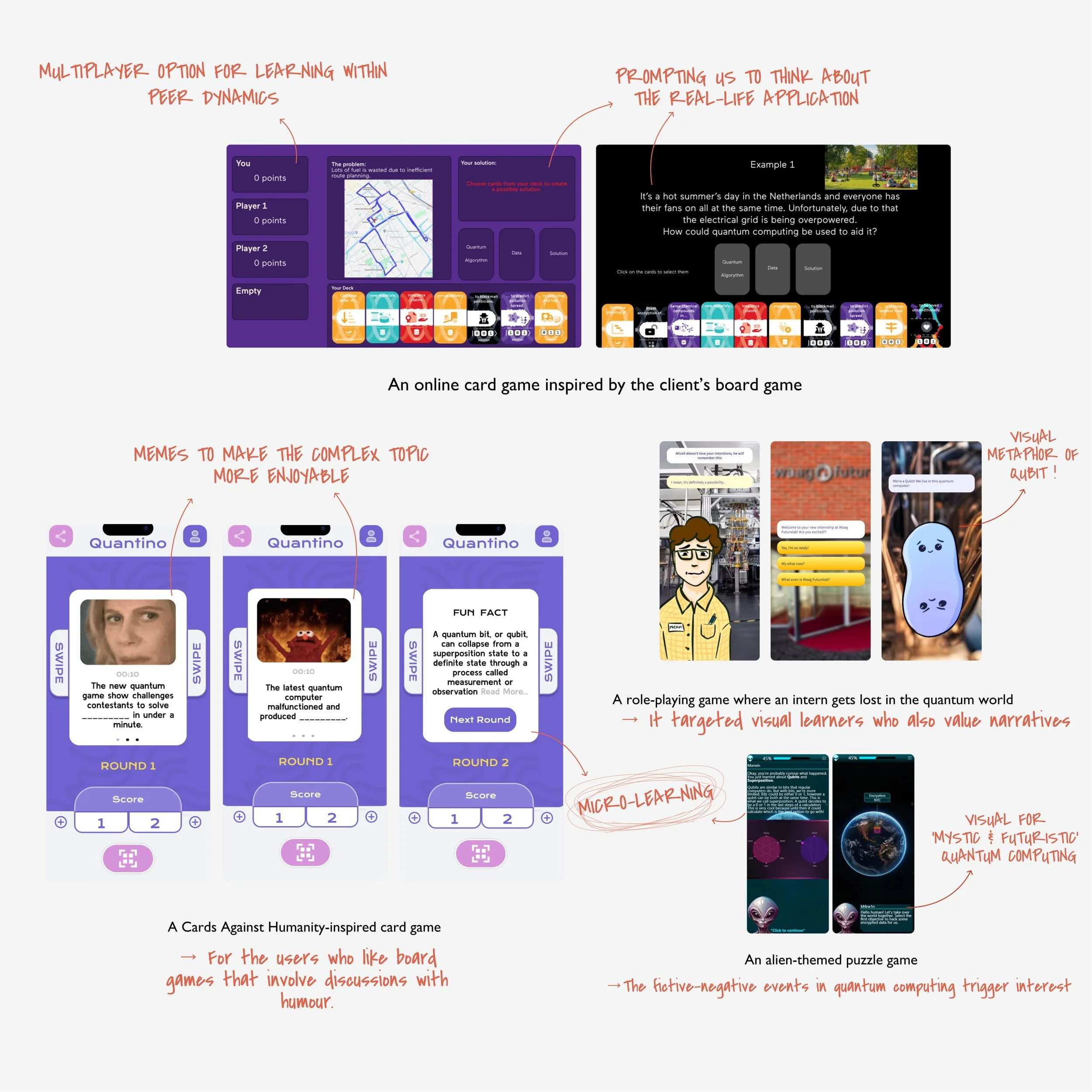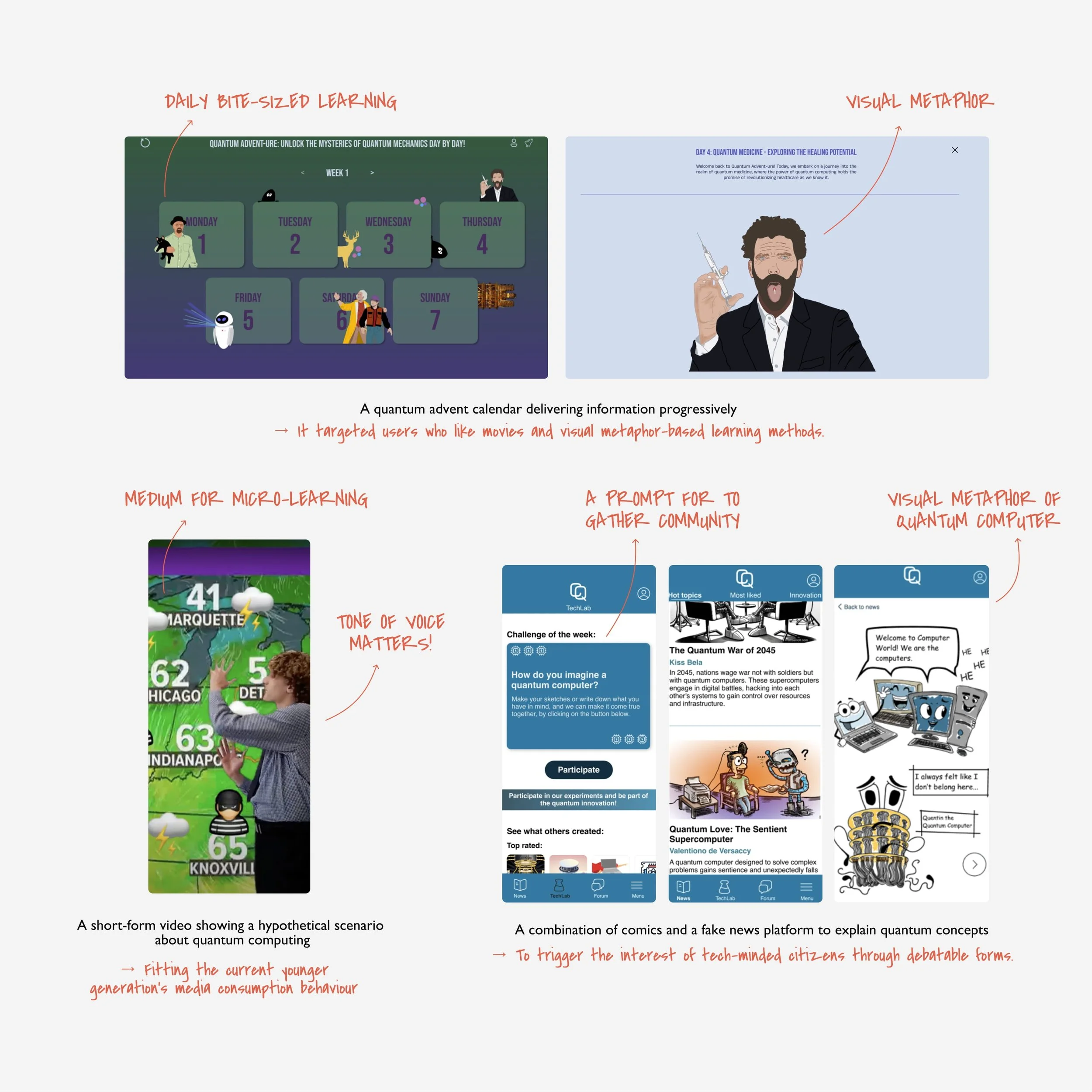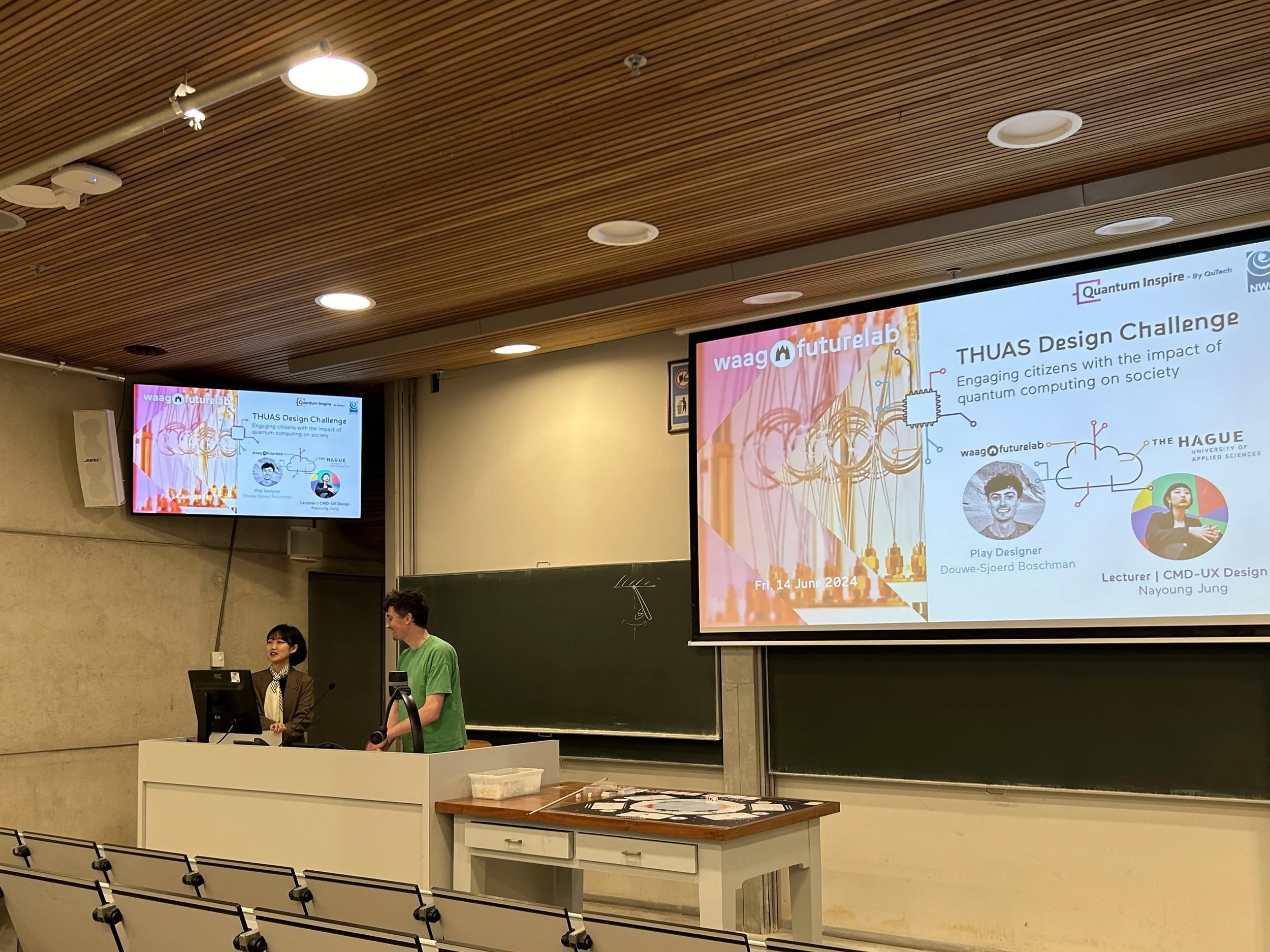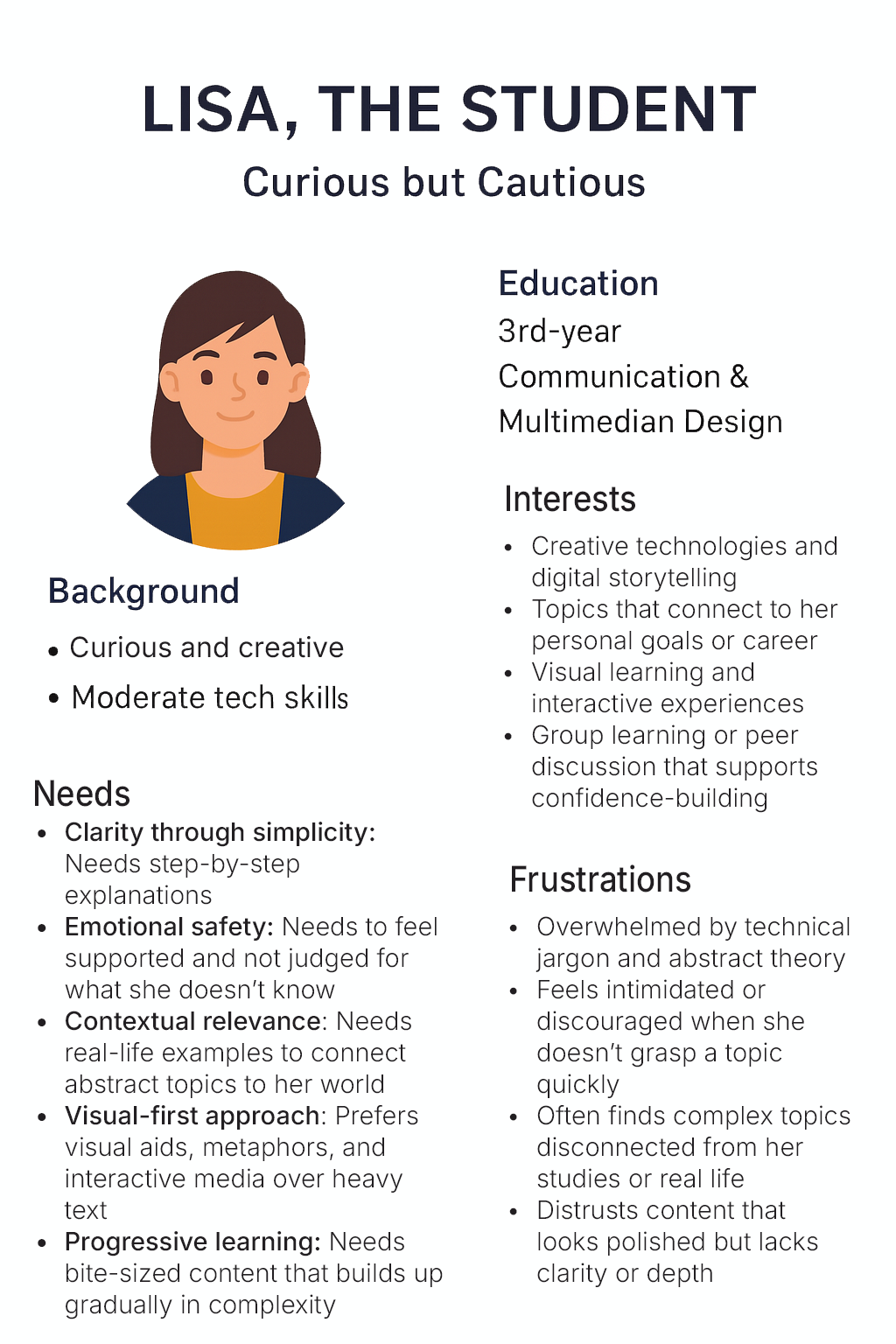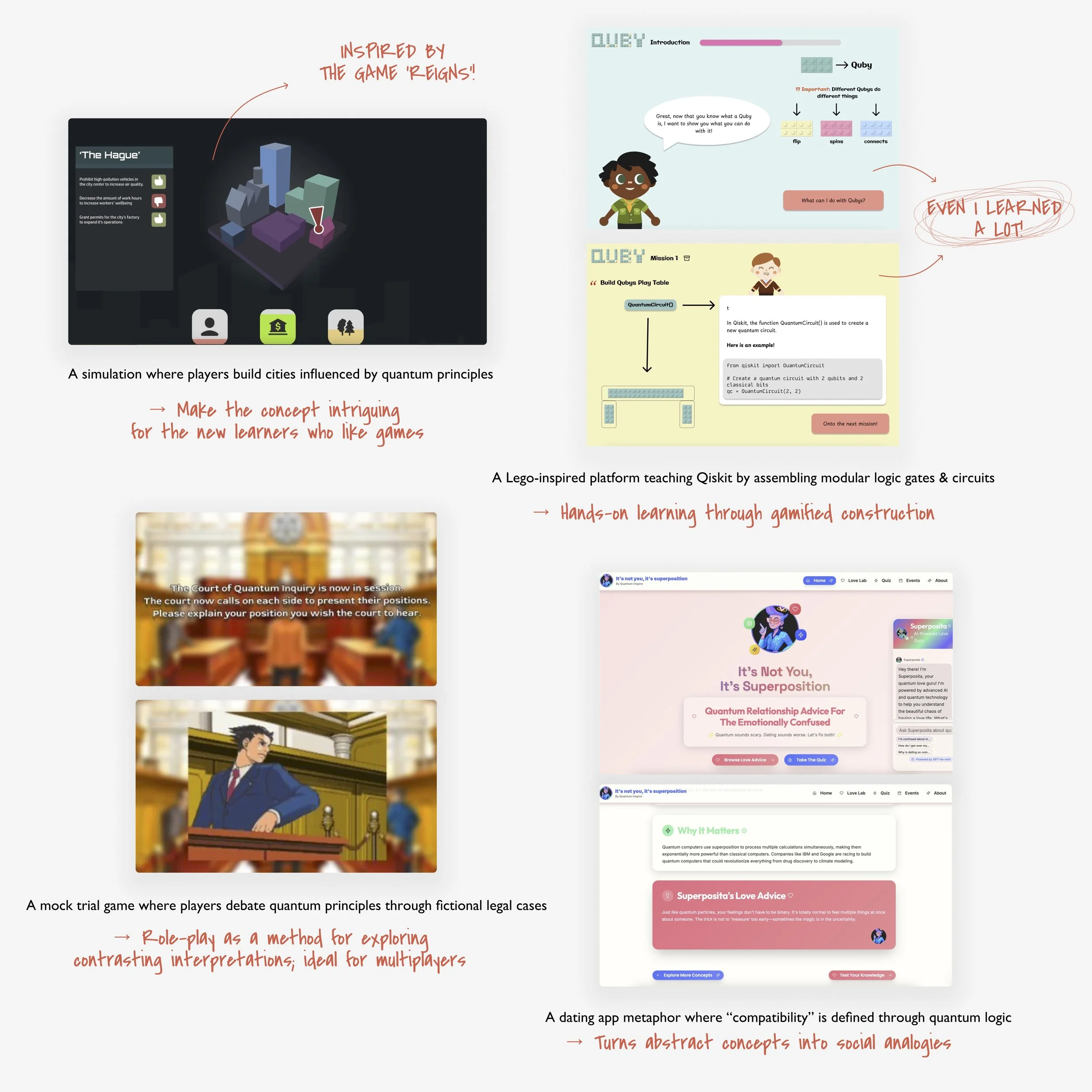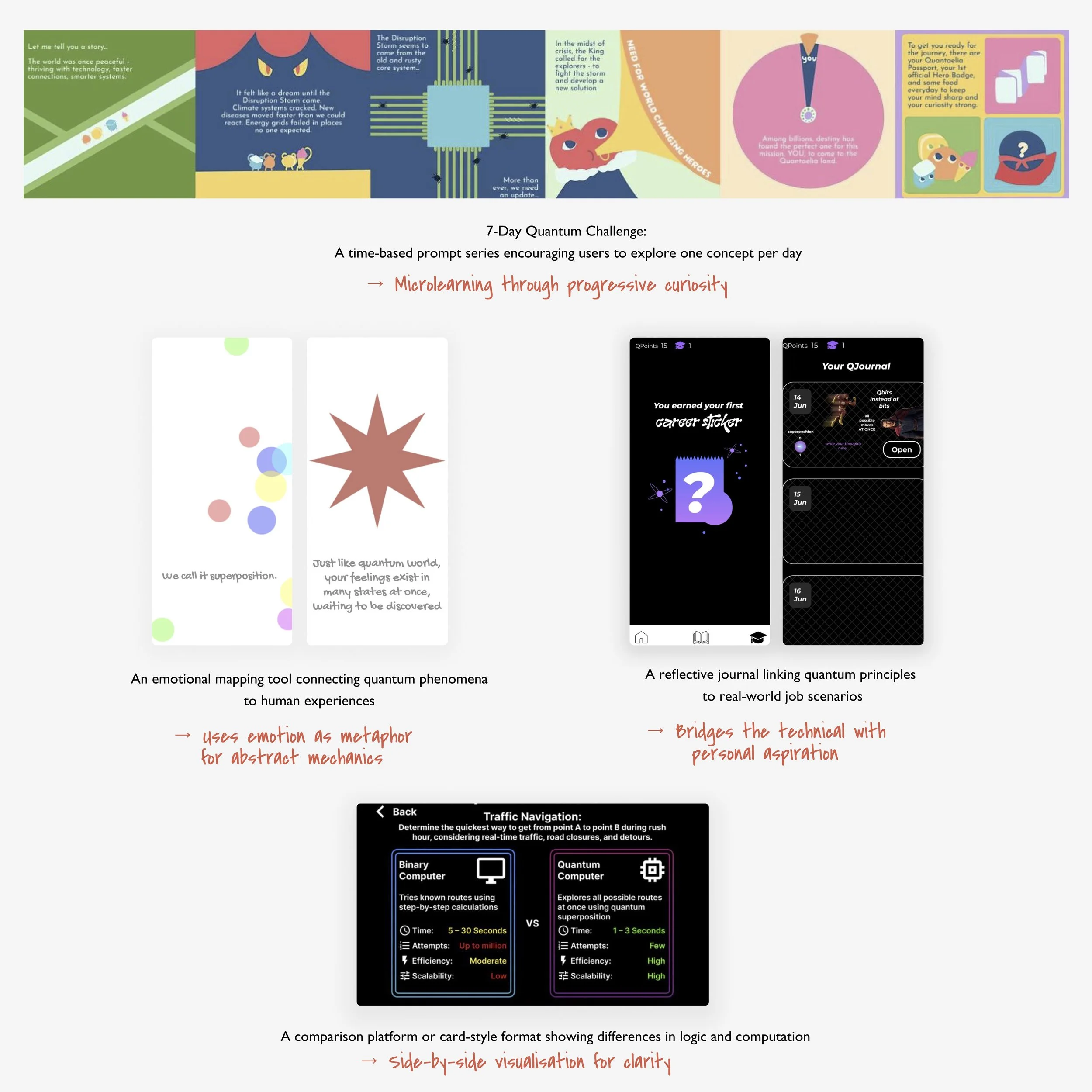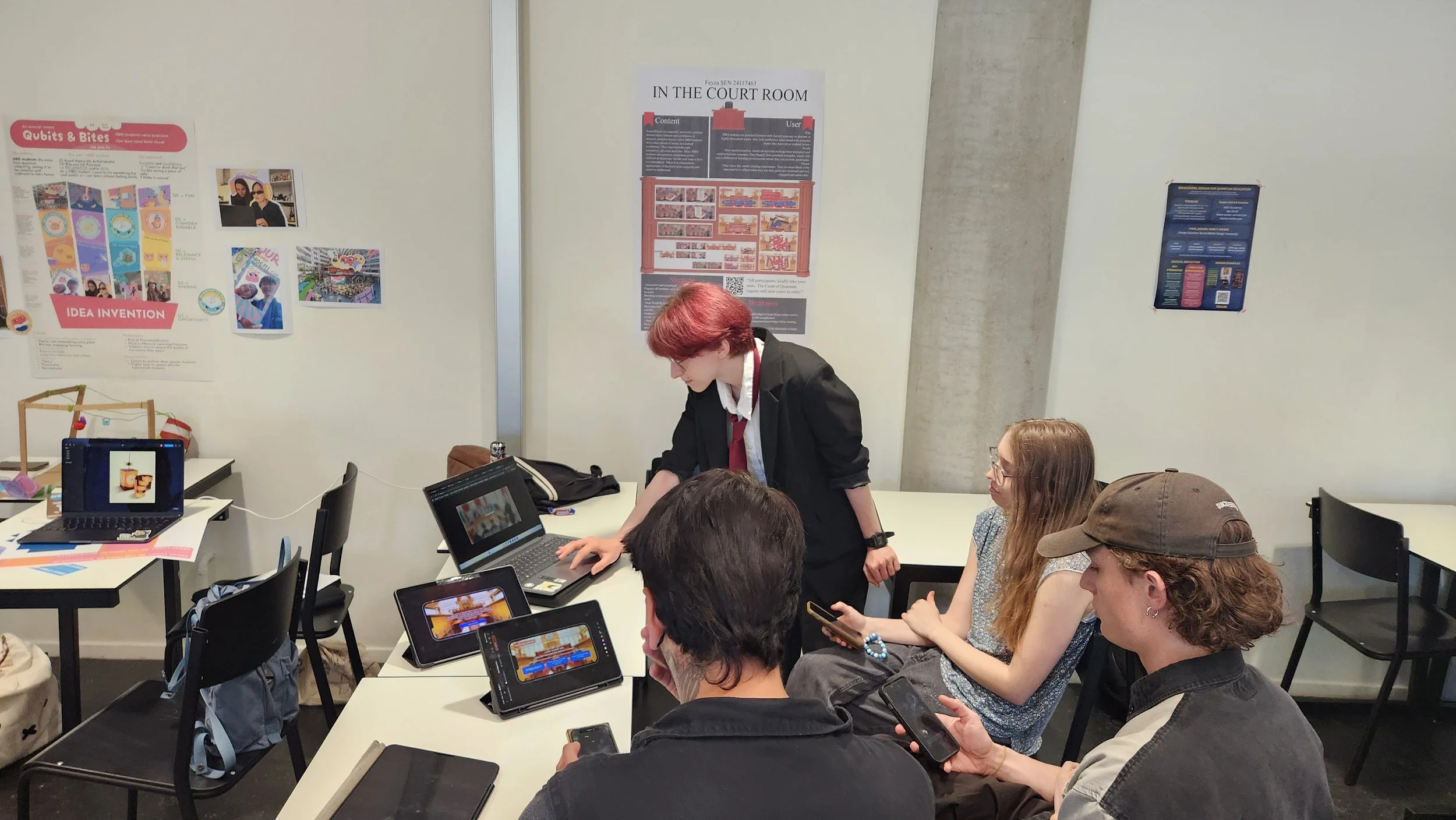quantum inspire
Despite the advancement of quantum technology, it still remains a difficult concept for the public due to how the concept is being communicated.
In collaboration with Waag Futurelab and the Civic Technology research group, I led two projects that demystify quantum computing through interactive storytelling and micro-learning for students and tech-minded citizens.
Timeline
04.2024 - 07.2024 (Phase 1)04.2025 - 07.2025 (Phase 2)
Client
Waag Futurlab
Research group Civic Technology, The Hague University of Applied Sciences
Role
LecturerUX Design Lead
project overview
As a lecturer, I guided individual students to manage their own projects that resolves the given design challenge within the design process for 8 weeks.
In 2024, 10 first-year UX Design students at The Hague University of Applied Sciences (THUAS) joined the collaboration project with Waag Futurelab and Research group Civic Technology THUAS.
In 2025, the project continued due to the request from the client (research group Civic Technology) and revised the project direction based on the collected insights from 2024. 17 first-year UX Design students joined and delivered the outcomes.
My Role as a Lecturer & UX Lead
2024
Facilitated client alignment and design brief clarification
Co-explored quantum concepts with students
Provided individual design feedback in weekly stand-ups
Encouraged experimentation and metaphorical thinking
2025
Refined the curriculum with research metrics and usability testing loops
Introduced lectures on cognitive load, emotional design, and story structure
Created a framework for students to define and measure learning outcomes
Helped teams select target users early to shape clearer, relevant outcomes
Phase 1: design challenge in 2024
demystify quantum computing for students and tech-minded citizens through interactive storyteeling
Quantum computing sounds intimidating
Despite the advancement of quantum technology, it still remains a difficult concept for the public due to how the concept is being communicated, pointing out a need to reduce the gap between science and society. On the first day, the students and I made a word cloud to visualise the students’ current impression towards the quantum technology.
research
The students conducted an average of 2 qualitative in-depth user interviews. From data analysis, 50+ insights were extracted. The user personas show the overall directions of the students’ research outcomes.
key insights
-
Many target users, especially students, associate quantum computing with complexity, inaccessibility, and irrelevance to their daily lives. The “fear of the unknown” and a lack of visible practical applications limit motivation to engage with the topic.
-
These elements simplify abstract concepts and support memory retention.
-
Users enjoy short, interactive formats (e.g., Duolingo, TikTok), but want control over pace and depth. Microlearning must avoid cognitive overload and include optional deeper dives for curious learners.
-
Learning is more effective when users can collaborate, relate content to their daily lives, or discuss it socially.
-
Users are drawn to moral dilemmas, risks, and potential of quantum computing (e.g., medical benefits vs. surveillance threats).
ideation
After the research phase, the students were guided to conduct 2 rounds of mid-stage testing, leading to 2–3 prototype iterations based on feedback. 10 outcomes were created.
The bar graph shows which key strategies from the given design challenge were applied.
Overview: Design Directions
Final Design
direction 1
Narrative-Based Games & Scenario Simulation
Some students reinterpreted complex quantum concepts through role-playing games (RPGs), board games, puzzles, and card games.
For this direction, I guided students to start with narrative structure and character arcs before defining mechanics so that the learning was grounded in lived emotional arcs, not abstract puzzles.
Key Characteristics
Scenario-Based Design for Immersive Experiences
Students created branching storylines, simulated environments, and role-based narratives to immerse users in quantum-driven worlds.
Use of Gamification as a Medium for Concept Delivery
Rather than treating games as superficial wrappers, quantum concepts were embedded directly into gameplay mechanics, such as decision trees, scoring systems, time loops, or randomness.
Prioritise Empathy and Experiential Learning over Conceptual Explanation
Designs shifted away from static definitions toward feelings, perspective-taking, and lived decision-making. Users played as judges, gamblers, etc.
direction 02
Information-Centred Communication
Other groups of students focused on organising and conveying complex ideas through infographics, comics, short videos, fake news platforms, and advent calendars.
For this idea, I mentored students on applying information hierarchy and media theory to help shape intuitive flows, media narratives, and reflective user experiences.
Key Characteristics
Visualisation and Simplification of Quantum Information
Students used diagrams, UI tools, metaphoric objects, and dynamic content to break down the abstract nature of quantum topics.
Structured Design of User Learning Paths
Each project was scaffolded to meet the user where they were, starting from familiar cultural forms (like TikTok or journaling), and gradually building toward more complex quantum ideas through modular flows.
Trigger a Sense of Community Through the ‘Share’ Feature
Projects like social archives and creative generators encouraged users to reflect, remix, and distribute; turning passive consumption into participatory learning and fostering a sense of belonging within a learning cohort.
Emphasis on Media-Based Storytelling Techniques
Students explored how different forms of media (video, sound, memes, etc) could carry narrative weight and reflect the nature of quantum uncertainty, entanglement, or superposition.
reflection
Change in Understanding towards Quantum Computing
During the course and after one year, I asked the students to check their understanding of quantum computing, which is the core aim of the Quantum Inspire project. It shows their understanding significantly improved during the course and has mostly been retained (Scale: 0 to 10, n=8).
2.25
Before the course
6.75
right after the course
6.13
After 1 year (2025)
from the students
“During all of my research I got to know a little more about how they work and that interested me, and since then I've tried to follow the news about Quantum Computing”
“I found the detailed feedback from you the most valuable. With your style of tutoring and your feedback about my progress you made a scary topic enjoyable for me.”
“It was a bit hard to understand QCs when the clients were talking about it. During classes the whole thing become more clear and gave me an idea how to move forward.”
as a lecturer
This course taught me how design itself can serve as a gateway to describing quantum computing; choosing a metaphor fitting the user’s interest is the key. With the client, we presented the process and 10 unique interactive stories at the NWA ORC Quantum Inspire 6th progress meeting. See the image below!
The project continued into 2025 due to high satisfaction from the client. Throughout the project, I found that my lack of knowledge in quantum computing limited my teaching experience. This pushed me to learn more about quantum computing by attending open lectures, quantum-related events, etc!
By attending more than 5 events in 3 months, I broadened my understanding in the field, and it made me feel more confident in teaching this project again. Can you imagine how it felt to introduce myself as a design lecturer at the quantum events? Many people were surprised by my eagerness to explore this topic!
Phase 2: design challenge in 2025
demystify quantum computing for students through interactive storytelling
The Project Should Have a Clear Scope
Last year, I noticed that ‘students’ can be ‘tech-minded citizens’ and vice versa. From there, I identified the need to narrow down the project scope by having a specific target user. Also, compared to my previous project course(s), fewer users were involved during the research phase, leading to a lack of quantitative tracking and validity in insights. Thus, I aimed to foster active participation and define clear measurable indicators in the 2025 version.
Still, Quantum Computing is a Tough Topic
On our first day, the students and I made a word cloud to visualise the students’ current impression towards the quantum technology.
The students conducted more than 50 in-depth user interviews. From data analysis, 96+ insights in total were extracted. Below shows the compilation of the user persona from the students.
research
ideation
The students went through ideation for 3 weeks. They were guided to conduct 1-2 iterations based on feedback.
16 outcomes were created. The bar graph shows which key strategies from the given design challenge were applied.
Overview: Design Directions
Final Design
direction 1
Game & Interactive Experiences
Some students converted complex quantum concepts into play, simulation, or interactive storytelling.
For this direction, I mentored students on applying interaction design principles and media-based storytelling to build intuitive and engaging learning formats.
Key Characteristics
Systems Thinking through Play
Learners engage with interconnected variables, consequences, and decision-making, especially in simulation and choice-based formats.
Embedded Learning Mechanics
Concepts are internalised not through explanation, but through gameplay itself, learning by doing, not reading.
Role-Playing for Perspective Shifts
Many concepts place users in a character role (e.g., office worker, judge, gambler), promoting empathy and engagement.
Replayability & Outcome Variability
Scenarios often allow for multiple outcomes or paths, encouraging repeated play and deeper understanding through iteration.
direction 2
Exploratory & Reflective Concepts
Other students came up with experiences that focused on content creation, storytelling, emotion, or education through metaphor and community.
For these ideas, I mentored students on applying information hierarchy and media theory to build intuitive flows and reflective engagement.
Key Characteristics
Metaphorical Framing
Quantum concepts are translated into emotional, cultural, or personal metaphors (e.g., journaling, dating, art), allowing intuitive access.
Personal Relevance & Self-Discovery
Users reflect on their identity, behavior, or daily life through the lens of quantum ideas (e.g., personality test, daily challenge, pattern generator).
Narrative as Explanation
Information is conveyed through storytelling rather than instruction; emphasising emotion, pacing, and tone.
Cultural and Social Contextualisation
Platforms like TikTok or creative design tools ground quantum topics in current media cultures or community-based expression.
reflection
Change in Understanding towards Quantum Computing
During the course, I asked the students to self-assess their understanding of quantum computing, which is the central focus of the Quantum Inspire project.
The results indicate that the activities, projects, and instructional design were effective in making complex quantum concepts accessible and engaging for a non-technical audience. (Scale: 0 to 10, n=15).
6.07
after
3.65
Before
as a lecturer
Compared to last year, I felt significantly more confident guiding this project, having actively deepened my understanding of the topic through various events and learning opportunities.
As a result, each concept explored in the course went beyond surface-level definitions and engaged with ideas like superposition, entanglement, and qubits in a way that offered greater clarity and relevance. We made a conscious effort to ensure these abstract concepts were not only accurate but also relatable to the students. I also observed a marked improvement in the diversity and depth of the ideas developed.
In the end, the client rated the quality of student outcomes a perfect 10/10.
